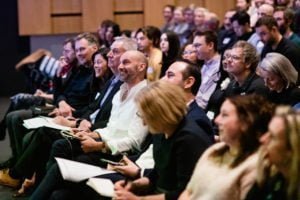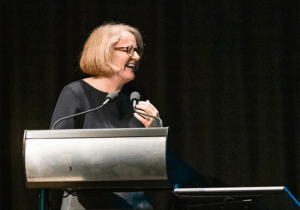Architecture conferences once held little interest for Sarah Hobday-North, but the recent ArchiTeam Conference has forced her to reassess.

If you didn’t make it to the Melbourne Museum this year for ArchiTeam’s bi-annual conference, Making a Living, here are four punchy ideas you missed:
- architecture is not creative
- architects are pretty rubbish at research
- architects are pretty rubbish at communicating their value
- you should get someone else to run your business
I’ve got a confession to make. I’d never been to a “pure” architecture conference before. I mean, one created by architects for architects. They had just never appealed to me – too much talk of juxtapositions, semiotics and celebration of established and assumed hierarchies. Or so was my perception.
My prejudice towards architecture conferences is why I jumped at the chance to attend Making a Living. This sounded like an architecture conference created to stir up and disseminate the stuff that architects can actually share – a common experience of business and professional challenges. Not pictures of other people’s work, but the business behind what those pictures represent. The work we did see from Matt Hinds and Jorge Ambrosi was beautiful in its own right, but the narrative was about the process, and even the payment, behind its delivery. Learning that Ambrosi Etchegaray continues to be paid by a winemaker in sparkling mescal gave us a different appreciation of the spaces they designed.
Throughout the day, in the friendliest possible way (and sometimes quite directly), 220 architects running solo, small and medium practices were shown that most of us are doing the business of architecture all wrong. Well, maybe not completely wrong, but there’s definitely room for improvement. A good first step, laid down by our first guest speaker, Timothy Hill, would be to abandon any ideas of architects as custodians of creative genius. He matter-of-factly liberated us from such delusions, saying that our profession should no more champion creativity than surgeons.
“Would you like to be operated on by a creative surgeon?”, he asked. The crowd giggled. Rather, architecture is a profession responsible for implementing a body of knowledge. Nothing more, nothing less. The key point for the conference is that seeing the profession in that light is really good for business, because it makes processes repeatable, research applicable, and value visible to clients.
It’s not all our fault though. We can blame the academics! See, we architects just aren’t taught to be business people, but then we end up running our own practices. And we aren’t taught how to think about research in practice and wonder why no-one understands us. Championing academia, Professor Flora Samuel of Reading University presented her research on bridging the gap between practice methodologies (yes, we have them) and the methodologies of research. If Samuel beseeched us to do just one thing, it was Post Occupancy Evaluation. Do POE. Learn from POE. Contact your clients once they have experienced the building and had time to reflect on the process. Then, tell your next clients with confidence what is so valuable about the work you do, and improve wherever you can.

Over half the speakers were non-architects. We were given small business advice by chef Ben Shewry of Attica restaurant, tools for managing the creative process by Hardhat media director Justin Kabbani, tips on knowing your product by environment entrepreneur Frankie Layton, and passionately dispassionate business coaching by Ray Brown. Perhaps this was an unconventional architecture convention because it didn’t, at a quick glance, appear to have much architecture in it. But, of course, this is what made it valuable. If “we” are to make a living from architecture, then we need to be able to communicate its value to the wider world – to non-architects. When we are successful in that, we might also expect to make, not just a better living, but have a larger influence on public policy and the way the world works. But let’s not get ahead of ourselves. Making sure you and your employees go home at 5.30pm (not 11pm) is a good start.
Five more takeaways from Making a Living 2019:
- Hire people who know things you don’t, and then let them do it
- Look after the business as well as the clients
- Invest in research
- Be prepared to change
- Check your prejudices (especially against attending conferences).
Sarah Hobday-North is a registered architect and founder of the Value Architects Group. She’s a spatial problem solver and loves making architectural knowledge hyper-accessible through low-cost/high-value services. She also loves singing 500-year-old choral music.
Photos: Greg Briggs.




















